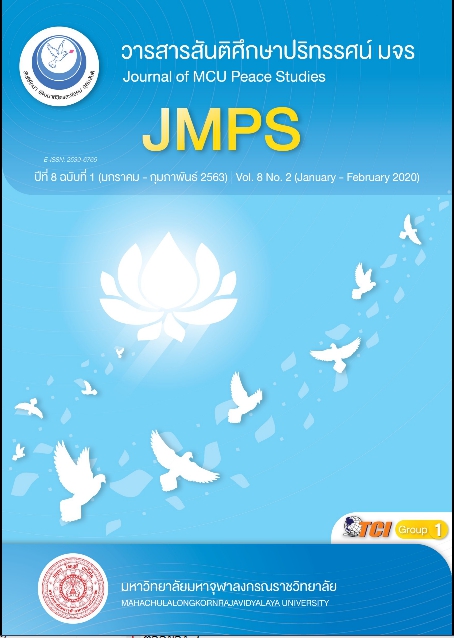Antecedents of Sustainable of Less Visited Area Tourism
Main Article Content
Abstract
The objectives of this research were to study the influences of destination environment, destination amenities, destination image, and tourist satisfaction on sustainable of less visited area tourism. This research employed a quantitative method. The sample consisted of 300 Thai tourists who used to travel to less visited area include Buriram, Ratchaburi, Satun, Lampang and Chanthaburi, obtained by multi-stage sampling. The sample size was determined based on the Kline criterion of 20 times the observed variables. Data were collected with the use of a questionnaire and analyzed with a structural equation model. The research findings showed that destination image had the highest overall influence on sustainable of less visited area tourism, followed by destination environment, tourist satisfaction, and destination amenities, respectively. The results of this research can be used to plan tourism strategies of the government and entrepreneurs in the less visited area pushing tourist attractions in the less visited areas to become a popular destination for both Thai and foreign tourists.
Article Details
Views and opinions expressed in the articles published by The Journal of MCU Peace Studies, are of responsibility by such authors but not the editors and do not necessarily reflect those of the editors.
References
Bagdare, S. (2016). A Conceptual Framework for Management of Tourism Experience. Imperial Journal of Interdisciplinary Research, 2(6), 718-722.
Chen, C. F. & Chen, F. S. (2010). Experience Quality, Perceived Value, Satisfaction and Behavioral Intentions For Heritage Tourists. Tourism Management, 31(1), 29-35.
Goeldner, C. R., Ritchie, J. R. B. & McIntosh, R. W. (2000). Tourism Components and Supply. Tourism: Principles, Practices, Philosophies, 362-393
Grappi, S. & Montanari, F. (2011). The Role of Social Identification and Hedonism in Affecting Tourist Re-Patronizing Behaviors: The Case of an Italian Festival. Tourism Management, 32(5), 1128-1140.
Kassean, H. & Gassita, R. (2013). Exploring Tourists Push and Pull Motivations to Visit Mauritius as a Tourist Destination. African Journal of Hospitality, Tourism and Leisure, 2(3), 1-13.
Kline, R. B. (2005). Principle and Practice of Structural Equation Modeling. New York: Guilford.
Lee, C. K., Lee, Y. K. & Lee, B. (2005). Korea’s Destination Image Formed by the 2002 World Cup. Annals of Tourism Research, 32(4), 839-858.
Loureiro, S. M. C. & González, F. J. M. (2008). The importance of quality, satisfaction, trust, and image in relation to rural tourist loyalty. Journal of Travel & Tourism Marketing, 25(2), 117-136.
Master Card Global Destination Cities Index. (2018). Big Cities, Big Business: Bangkok, London and Paris Lead the Way in Master Card’ S 2018 Global Destination Cities Index. Retrieved February 4, 2019, from https://newsroom.mastercard.com/
Ministry of Tourism and Sports. (2019). Summary of the Camp Situation Number of Visitors and Income from Visitors Jan - Dec 2018. Retrieved January 31, 2019 from https://www.mots.go.th/ more_news.php?cid=509&filename=index
Morrison, A. & Anderson, D. (2002). Destination branding. In Annual Meeting of the Missouri association of convention and Visitor Bureaus, 17.
Phillips, W. J., Wolfe, K., Hodur, N. & Leistritz, F. L. (2013). Tourist Word of Mouth and Revisit Intentions to Rural Tourism Destinations: A case of North Dakota, USA. International Journal of Tourism Research, 15(1), 93-104.
Prayag, G., Chen, N., Hosany, S. & Odeh, K. (2016). The cognitive-affective relationship of tourists to a heritage site: The case of Petra. TTRA Canada 2016 Conference. Retrieved March 25, 2016, from https://scholarworks.umass.edu/ttraca nada_2016_conference/25
Rajesh, R. (2013). Impact of Tourist Perceptions, Destination Image and Tourist Satisfaction on Destination Loyalty: A Conceptual Model. Pasos. Revista de Turismo y Patrimonio Cultural, 11(3), 67-78.
Ramkissoon, H., Uysal, M. & Brown, K. (2011). Relationship between Destination Image and Behavioral Intentions of Tourists to Consume Cultural Attractions. Journal of Hospitality Marketing & Management, 20(5), 575-595.
Sirisom, W. (2017). Sustainable Thai Tourism... Emphasizing Quality, not focus on Quantity. Retrieved March 23, 2019, from https://www.matichon.co.th/economy/news_1303118
Thai Rath Online. (2018). TAT Invites You to Experience the Charm of “Muang Rong”. Once Tried, Will Fascinate. Retrieved Febuary 26, 2018, from https://www.thairath.co.th/ content/1363765
Wanich, Y. (2019). 50th Thai Tiew Thai. Retrieved March 23, 2019, from https://www.thairath. co.th/news/business/1502300

